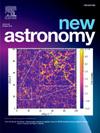Universal relationships for neutron stars from perturbative approach
IF 2.1
4区 物理与天体物理
Q2 ASTRONOMY & ASTROPHYSICS
引用次数: 0
Abstract
The universal relationships for compact stars have been investigated employing perturbative approach using canonical (APR) and Brussels–Montreal Skyrme (BSk22, BSk24, BSk26) equations of state describing hadronic matter of neutron stars. The neutron star matter has been considered to be -equilibrated neutron–proton–electron–muon matter at the core with a rigid crust. The multipole moments of a slowly rotating neutron star characterize its external gravitational field. These variables are dependent on the interior structure of the neutron star described by the equation of state of the neutron star matter. The properties of neutron stars, such as the mass, the radius, the dimensionless moment of inertia, the compactness, the Love number, the dimensionless tidal deformability and the dimensionless quadrupole moment have been calculated and relations among these quantities have been explored. It is found that most of these relations do not depend sensitively on the details of the internal structure of neutron stars. Such universality implies that the measurement of a single quantity appearing in a universal relation would automatically provide information about the others, notwithstanding the fact that those may not be accessible observationally. Such relations can be utilized to assess the deformability of compact stars by measuring their moment of inertia, to evaluate spin in binary inspirals by resolving degeneracies in gravitational wave detection or to examine General Relativity in a manner that is not reliant on nuclear structure.
从摄动方法看中子星的普遍关系
利用正则态方程(APR)和描述中子星强子物质的brussel - montreal Skyrme (BSk22, BSk24, BSk26)状态方程,采用微扰方法研究了致密星的普适关系。中子星物质被认为是具有刚性外壳的β-平衡中子-质子-电子-介子物质。缓慢旋转的中子星的多极矩是其外部引力场的特征。这些变量取决于中子星物质状态方程所描述的中子星内部结构。计算了中子星的质量、半径、无因次转动惯量、紧致度、Love数、无因次潮汐变形量和无因次四极矩等性质,并探讨了这些性质之间的关系。我们发现,这些关系中的大多数并不敏感地依赖于中子星内部结构的细节。这种普遍性意味着,对普遍关系中出现的单个量的测量将自动提供关于其他量的信息,尽管这些量可能无法通过观测获得。这种关系可以用来通过测量它们的转动惯量来评估致密恒星的可变形性,通过解决引力波探测中的简并来评估双星的自旋,或者以一种不依赖于核结构的方式来检验广义相对论。
本文章由计算机程序翻译,如有差异,请以英文原文为准。
求助全文
约1分钟内获得全文
求助全文
来源期刊

New Astronomy
地学天文-天文与天体物理
CiteScore
4.00
自引率
10.00%
发文量
109
审稿时长
13.6 weeks
期刊介绍:
New Astronomy publishes articles in all fields of astronomy and astrophysics, with a particular focus on computational astronomy: mathematical and astronomy techniques and methodology, simulations, modelling and numerical results and computational techniques in instrumentation.
New Astronomy includes full length research articles and review articles. The journal covers solar, stellar, galactic and extragalactic astronomy and astrophysics. It reports on original research in all wavelength bands, ranging from radio to gamma-ray.
 求助内容:
求助内容: 应助结果提醒方式:
应助结果提醒方式:


